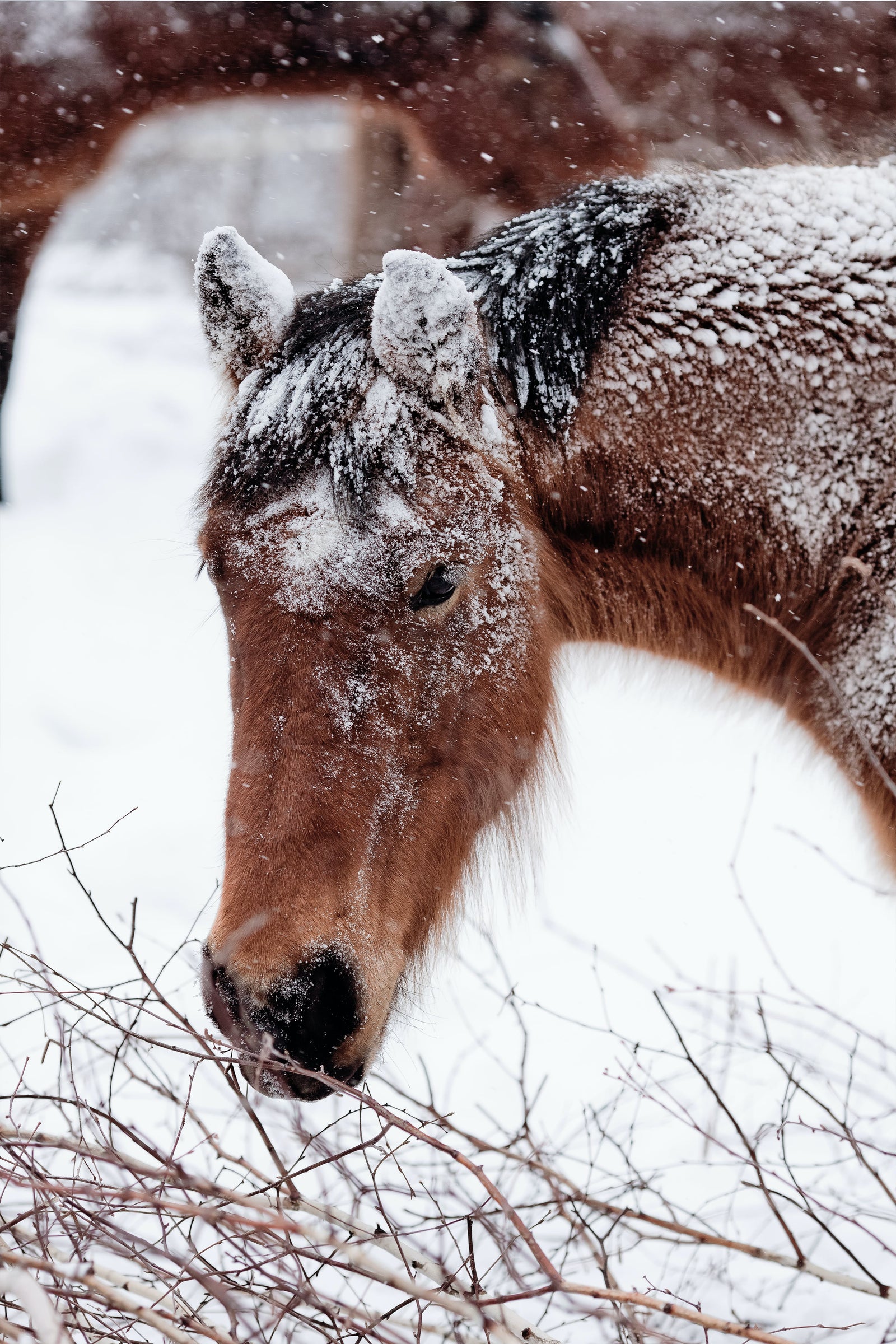Preventing Winter Laminitis: Essential Care Tips for your Horse

What is Winter Laminitis?
Laminitis is a painful and potentially debilitating condition affecting the tissues (laminae) that bond the horse's hoof wall to the underlying pedal bone. While often associated with lush spring pastures, laminitis can occur during any season, including winter, presenting unique challenges in its management and prevention. Triggered by the cold weather, winter laminitis affects horses with metabolic problems, PPID, or a history of laminitis at a higher rate than other horses.
Winter laminitis, though fundamentally similar in its effect on the laminae within the hoof, presents unique challenges and causes that distinguish it from other forms of laminitis experienced in warmer seasons. Understanding these differences is crucial for effective prevention and management. The role of circulation and the arteriovenous anastomosis (AVA) shunts in the development of winter laminitis is a complex and critical aspect of understanding this condition.
What is the importance of circulation in the hoof?
Proper circulation in the horse's hoof is crucial for delivering nutrients and oxygen to the tissues, including the laminae, and removing metabolic wastes. The hoof is a highly vascular structure, with blood flow regulated to meet its metabolic needs and to adapt to environmental temperature changes.
What are Arteriovenous Anastomoses (AVA)?

Arteriovenous anastomoses (AVAs) are specialized vascular structures that direct blood from arteries to veins, bypassing the capillary system. In the equine hoof, AVAs play a significant role in thermoregulation. During cold weather, the AVAs can constrict to reduce blood flow to the extremities, helping to conserve body heat by redirecting blood flow away from the skin and extremities and towards the core of the body. While beneficial for maintaining core body temperature, this thermoregulatory response can harm hoof health.Pollitt, Chris & Kyaw-Tanner, Myat & French, Kathryn & Eps, A & Hendrikz, J. & Daradka, Mousa. (2003). Equine Laminitis. Proc. Am. Ass. equine Practnrs. 49.
The constriction of AVAs in response to cold can lead to reduced blood flow to the hoof, which is a primary factor in the development of winter laminitis for several reasons:
- Reduced Nutrient and Oxygen Supply: Diminished blood flow compromises the delivery of nutrients and oxygen to the hoof tissues, weakening the laminae and making them more susceptible to damage.
- Impaired Waste Removal: The reduced circulation hampers the removal of metabolic wastes from the hoof tissues, contributing to toxic buildup that can further damage the laminae.
- Increased Susceptibility to Inflammation: The hooves are also more prone to inflammation with impaired blood flow. The reduced ability to clear inflammatory mediators can exacerbate the condition.
What are some Causes of Winter Laminitis?
Winter laminitis can arise from several factors, often distinct from those typically implicated in warmer months:
- Reduced Physical Activity: Cold weather can lead to decreased exercise, contributing to weight gain and reduced circulation to the hoof.
- Insulin Resistance: Horses with metabolic issues, such as Equine Metabolic Syndrome (EMS) or Cushing's Disease (PPID), are at a higher risk; cold weather stress can exacerbate these conditions. An unpredictable seasonal insulin rise throughout the winter can contribute to winter laminitis.
- Changes in Feeding: Increased reliance on rich hay or concentrates to maintain body weight in winter can lead to dietary imbalances and trigger laminitis in susceptible horses.
- Cold Temperatures: In frigid climates, reduced blood flow can damage laminae, leading to laminitis.
How to Manage and Prevent Winter Laminitis:
Prevention is critical in managing winter laminitis, focusing on mitigating the risk factors before they cause harm:
- Hoof Care: Regular farrier visits and hoof care are crucial to ensure proper hoof health and early detection of any issues.
- Diet Monitoring: While diet is essential year-round, winter management emphasizes controlling calorie intake from hay and concentrates and ensuring a low (10% or below) NSC (non-structural carbohydrate) diet to prevent insulin spikes.
- Exercise and Activity: Maintaining exercise during winter is more challenging but essential for promoting circulation, preventing weight gain, and utilizing sugars in the bloodstream.
- Metabolic Support: Winter care for horses with metabolic issues may include adjusting medication or supplements to manage conditions like EMS or PPID better, reflecting the increased metabolic demands during colder weather.
- Maintain Body Temperature: Keeping horses warm will prevent their bodies from restricting blood flow to their hooves and help to prevent the onset of winter laminitis. Access to plenty of hay, blanketing, and sometimes applying hoof boots will help.
How do you treat Winter Laminitis?
Treatment of winter laminitis involves both immediate and long-term strategies to alleviate pain, address the underlying causes, and support hoof health:
- Veterinary Care: Immediate consultation with a veterinarian is critical. A physical exam will ensure you have an accurate diagnosis, and then the vet and caretakers can devise a treatment plan.
- Pain Management: NSAIDs (non-steroidal anti-inflammatory drugs) can be used under veterinary guidance to manage pain and inflammation. However, evidence shows these drugs are less effective when treating winter laminitis than when treating cases during warmer months.
- Corrective Hoof Care: A knowledgeable farrier can provide supportive shoeing or trimming to alleviate pressure on the laminae and promote healing.
- Support Circulation: Keeping the horse warm with blankets, boots, or leg wraps can help ensure the AVAs do not restrict blood flow to the hooves.
What Supplements will help with Winter Laminitis?
Supplementation can play a supportive role in managing and preventing winter laminitis, particularly in horses with metabolic issues:
- Magnesium and Chromium: These minerals can help improve insulin sensitivity.
- Omega-3 Fatty Acids: Found in flaxseed and chia seed, omega-3s can reduce inflammation and support overall hoof health.
- Antioxidants: Vitamins E and C and selenium can support circulatory health and combat oxidative stress.
- L-Arganine: This amino acid supports blood flow by facilitating vasodilation.
- Jiaogulan: An adaptogen that promotes circulation by supporting nitric oxide precursors, helping blood vessels open.
Conclusion
Winter laminitis requires a tailored approach that addresses the unique challenges of colder weather, including metabolic stress, changes in feeding practices, and reduced physical activity. The circulatory dynamics involving arteriovenous anastomoses (AVA) play a critical role in the development of winter laminitis by affecting the blood flow and, consequently, the health of the laminae in the horse's hoof. Management and preventive strategies that support circulation can effectively mitigate the risk of winter laminitis. Consulting with your vet to ensure the best medication, feed, and supplement protocol in the fall can protect your equine companion from the pain and complications of winter laminitis; stay vigilant and proactive!
References:
Braithwaite, Sarah. “Winter Laminitis and the Cold.” Forageplus Talk, 22 Feb. 2022, www.forageplustalk.co.uk/winter-laminitis/.
Staff, Kentucky Equine Research. “Seasonal Soundness: Avoiding Winter Laminitis in Horses.” Kentucky Equine Research, 13 Jan. 2021, https://ker.com/equinews/seasonal-soundness-avoiding-winter-laminitis-in-horses/





Leave a comment